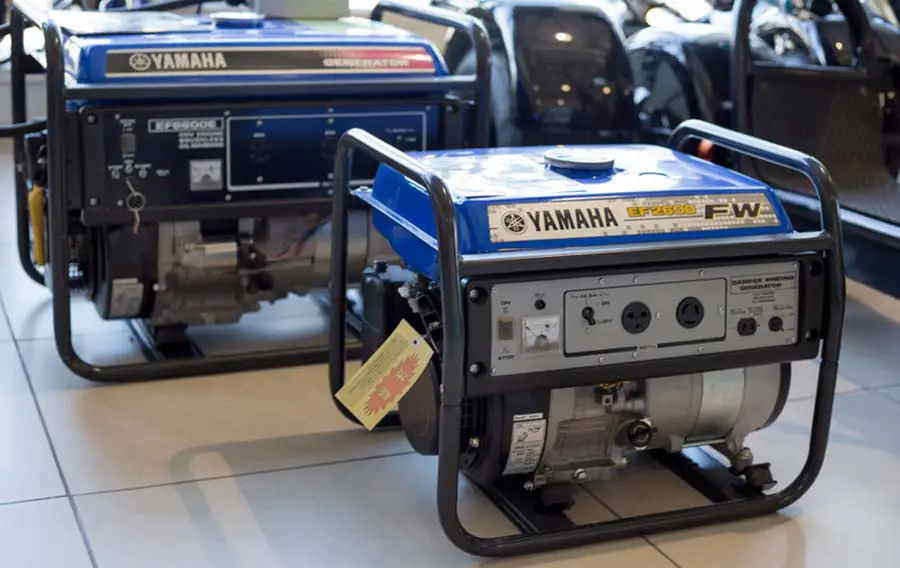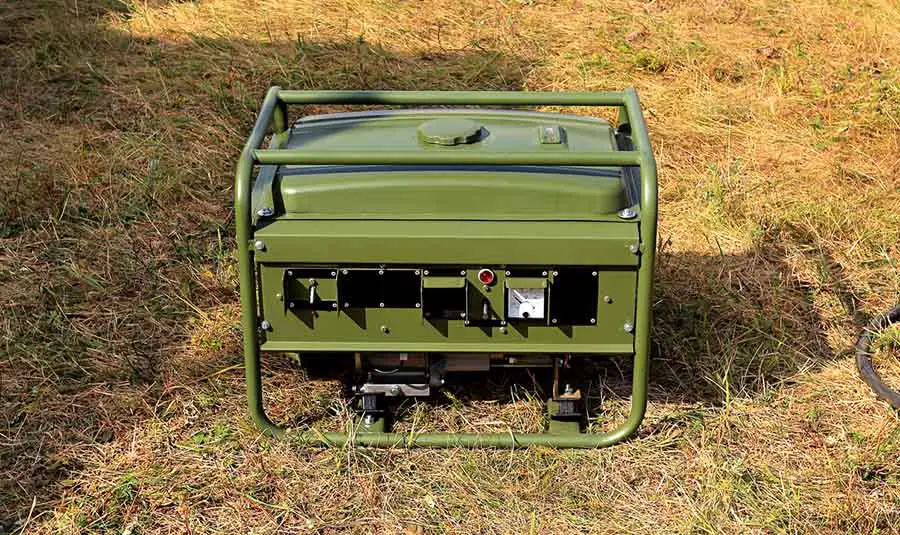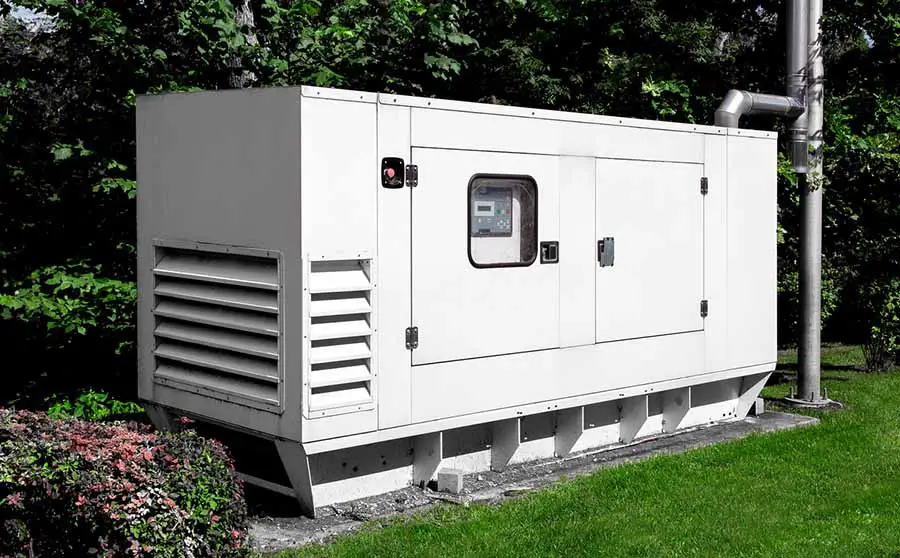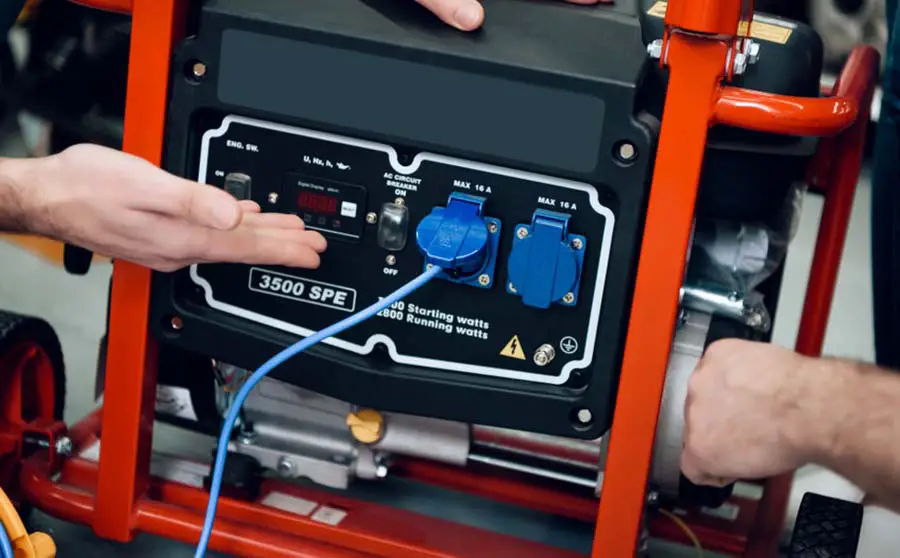
Understanding how to take care of your generator, where to put it, and why you can only use certain fuels will still leave many confused about how the generator makes power. The process of a generator making power is both complicated and straightforward, not much different from a power station.
Inside a power generator, there are two main components: an engine and an alternator. The engine burns fuel, producing mechanical energy that turns a central shaft. The shaft connects to the alternator, which uses magnets and copper spools to convert the mechanical power into electricity.
This article will give you a basic understanding of how generators work, but the entire process of turning engine movement into power is a bit more complicated. Knowing how many components are inside the generator and how they interact with each other is essential.
The Basic Components of a Power Generator
When significantly simplified, a generator consists of only two components: the engine and the alternator. However, if you ever find yourself having to disassemble the machine, it will quickly become several more, each one with its safety systems and warning that you must follow.
We usually break the generator into four main parts, with each helping make the system work in the best and most efficient way possible. Each part is not the same size, but they serve important purposes to ensure everything can talk to each other and do what it needs. Here are the four main parts of a generator:
- Engine
- Fuel system
- Power system
- Regulation system
Let’s take a more in-depth look at each of these parts and explore what they do exactly and how they help the generator function as a whole.
Engine
The engine is the central part of the generator, whether it is gas-powered or diesel-powered. The engine turns the potential energy held within the fuel of your choice into mechanical energy using internal combustion.
Generator engines are usually slightly different from car engines as they do not work with a gear system or work against a more significant amount of resistance. These engines turn the alternator and nothing else, making them highly efficient but unable to produce a lot of torque.
Fuel System
Every generator has a separate fuel system, relying on a carburetor and gravity, providing the engine with all the fuel needed. Usually, smaller generators, whether portable or not, will depend on carburetors, whereas larger generators, which are backup generators, the systems become complicated.
Larger diesel generators use fuel injection systems with the tank for the generator underground where it is safe. However, gas generators usually link up to either tanks or gas pipelines with valve systems that handle the generator’s amount of gas.
Power System
The power system of your generator consists of the alternator, the connecting shaft, and the outgoing power produced from it. At first, this can feel like the most complicated part of the generator because it consists of components that look similar to a typical electric motor.
However, the alternator on a generator is a set of coils wound around the shaft, always staying stationary. The shaft has a set of neodymium magnets that start spinning as the engine begins working; this produces an electrical current due to magnetic fields’ movement against the copper.
Regulation System
The engine is the generator’s heart, the fuel system is the system’s blood, and the alternator is the lungs. Then the regulation system has to be the system’s brains, controlling how hard the engine is working, how much power is being produced, and delivering everything.
The smallest component of the generator regulation system is the wires, the circuit boards, and the outgoing power lines from the generator. This will ensure that your generator is always working correctly, with generators with broken regulation systems either not starting or using too much fuel.
How Does a Generator Turn Engine Movement Into Power?

Now that we know each part of the generator and what it does, we can start looking at the entire process of turning fuel into electrical power. All generators follow the same basic principle despite the differences in sizes, fuel types, and efficiency.
We have seen many systems that claim to work differently, only to be torn apart and shown to work in the same way everyone expected. Understanding the movement and chemical reactions from fuel to final turning will completely understand generator power.
1. Fueling the System
Fueling is vital because all the power for your generator begins there, as all fuel types have potential energy. Gas, diesel, and even hydrogen all have different levels of potential energy held within them, all usually measured in joules as the measurement is a chemical measurement.
All potential energy converts into mechanical energy; however, much of this energy is lost because no system is perfect. Most systems usually lose around 50% to 80% of the energy to movement and heat that becomes entirely lost during the process.
2. Starting the Engine
Once you have fuel in the generator, you can start the engine, which always uses more fuel than when the generator is already running. The generator does not provide power during the starting process as you will be turning the engine, with the choke closed, trying to start combustion.
The older the generator is, the harder it will be to start, primarily if you have not serviced and maintained it properly throughout the years. Until you fully start the generator, the machine will produce only minimal power and may die if you pull power.
3. Internal Combustion
Once you’ve started the engine, the power production will start by completing the internal combustion process. This is when the pistons are pushing fuel and oxygen into a high-pressure environment, with a spark or heat causing combustion.
Combustion starts with a downward piston movement pulling in fuel and air from the valves and mixing them. As the pistons move up and combustion takes place, the potential energy from the fuel converts into explosive energy, which is then converted to mechanical energy by the piston moving down.
4. Movement of the Alternator
An alternator’s pistons attach to the crankshaft, which connects through gears, a chain, or a belt system to the shaft. This shaft connects to the alternator, which then starts spinning, using the mechanical energy from the pistons to turn the alternator.
These shafts are usually extremely short, with smaller generators sometimes having the shaft directly connected to the engine’s crankshaft. Usually, this is only on smaller generators because of the danger of the engine turning too fast, with no clutch to help save the magnetism.
5. Magnetic Field Movement
Once the shaft starts to turn, the alternator can start to produce the power; that is the whole reason that you would be using a generator. The shaft will spin the magnets attached to it, creating a magnetic field that moves out and through the copper spools surrounding it.
The faster the field movies, the more power it produces. There is usually a maximum set on the strength of the magnets and the overall amount of copper wire coils. The less copper wire you have, the less power you can produce, but more copper wires require more energy to turn the shaft.
6. Power Production
As the magnets turn, they spin a magnetic field around them; this magnetic field would normally go through other materials. However, copper resists and creates its magnetic field when in contact with the magnetic field created by the magnets.
As the magnetic fields interact, an electric charge builds up inside the coils; these coils transfer this electric charge into the control system. The electric charge created by the alternator is where the power comes from.
7. Control System
The control system controls how much power the generator produces, where the power goes, and how hard the engine needs to work. Some of the produced power will go back to keep the engine running, while the rest of the power produced will go to what you have plugged in.
If your control system is broken or starting to fail or simply unable to control your generator properly, it will cause the engine to die. Further, your engine may be turning, but the amount of power produced is not enough; the control system decides how effective your generator is.
The Basics of Generator Power Production
To make things easier to understand, we can take a look at the basics of how a generator produces power. We include this explanation to make it as simple as possible when you need to explain to someone how your generator works or why something went wrong.
The power inside your generator goes through three different stages, each losing some of the initial power that you may have. We always recommend that you consider these three things when you have to buy a power-generating system for your home or farm.
Potential Energy
The fuel put into your generator is the potential energy; this is the potential energy it can produce from the gasses or fuels you are using. Making any amount of power will start with the stored potential energy; the more potential energy something has, the more energy it can produce.
In nuclear power plants, the potential energy is stored within the radioactive materials, while coal-fired power plants have their potential power stored in the coal. However, in most systems currently used on earth, all the potential energy is not fully used in power production.
Mechanical Movement
Through combustion, the potential energy converts into mechanical energy; mechanical energy is always anything that is moving. In a generator, the mechanical movement is the pistons moving up and down. It pushes on the crankshaft, which moves the other components in the engine.
Engines that use internal combustion of any type will be converting combustion into mechanical energy that can then drive anything attached. A car engine works the same way as your generator engine, making combustion into mechanical power that moves the car.
Electrical Power
After creating mechanical movement, the last step for a generator is to get electrical power by moving the magnets in the alternator. The electrical power is usually the most intangible part of the generator when appropriately used because it is always there but only present when powering something.
We have seen many people become confused by how their generators work because they make a lot of noise. We always recommend that everyone always remembers that a generator is a system that takes combustion power and transforms it into electrical power.
How are Generators Similar to Electric Motors?

Many people don’t always understand that a generator motor is not similar to a standard electric motor, with the base similarities between the two being odd for beginners. We recommend that you know how they are different and why they are different from each other.
These motors can technically both produce power; however, they will be drastically different can will use power in different ways. While it is not entirely essential to know the difference between these two motors, it is a good piece of knowledge to have if you are ever required to replace one.
Transformation
An electric motor turns electrical power into mechanical movement by turning a shaft with a set of magnets on it, turning the shaft, which turns whatever is attached to it. Standard electric motors can produce power when turned but are not highly efficient and can sustain damage.
Generator motors turn mechanical energy into electricity and do almost nothing else, with no electrical feedback pushed into the coils capable of turning the motor. What many people mistake for an engine in the generator is the alternator.
Copper Coils
Electric motors have tightly controlled copper coils that determine how strong the motor is and how efficient it is. Fewer copper coils usually deliver more power but much less overall power, which is why you will find high torque motors cannot always have variable speeds.
The copper coils in generator alternators can have very varied copper coils, not focused on control or power. Instead, they focus on producing power, with more coils absorbing a lot more power from the magnetic field; however, the more coils there are, the harder it is to turn the shaft.
Central shaft
The generator shaft will have strong neodymium magnets attached to it to produce a strong magnetic field that will create the power. Electric motors will have the same system connected to the shaft, with a strong magnet or set of neodymium magnets that the electric field will push on.
The difference between the shafts is how they interact once a force is applied to the shafts, with the electric motor using an immense amount of torque. The alternator will not resist being turned, as it is made as light as possible to turn to make the energy production system efficient.
Can You Run a Larger Alternator To Produce More Power?
No, you cannot simply change out the alternator on your generator for a larger one to produce more power from the generator. The engine mounted in your generator will be able to overcome a certain amount of resistance in the magnetic fields that exist within your alternator.
If you install a larger alternator on your generator without doing anything to the engine, the internal wiring will start to fail because of the higher amplitude. Further, the engine will inefficiently run as it is working too hard to turn the shaft, which will eventually cause the system to fail.
In the same fashion, making the engine turn faster will not make the generator produce more power than it already produces at its maximum. This is why you cannot simply make a generator engine stronger to have the entire system producing more power.
Why a Generator Might Not Produce Power When the Engine Is On

Now that we know how a generator is producing power and the ins and outs of the machine, we need to look at what can go wrong in creating energy. It is essential to understand that several things can go wrong with the process that will cause it not to make any electricity.
Each of these is unlikely to happen when your generator is adequately maintained and has all the proper care given to it every 100 hours of operation. However, we recommend keeping these in mind if you ever find your generator decides to give up and have trouble working.
Loss of Magnetism
The most common thing to happen is your generator losing its magnetism, which means that it can no longer produce any power. The magnetism of the alternator can be lost when the generator runs until it’s out of fuel, which causes appliances running off the system to drain out all power.
Your alternator can usually survive this happening three to four times before losing its magnetism entirely, and if you use it a lot afterward, it will not be such a big problem. However, it is still unhealthy, and it is always better to have the generator shut down and refueled.
Broken Shaft
This is more likely to happen with older generators than it would happen with a younger than ten years old generator. You can shear the shaft connecting the engine to the alternator if the engine is running too fast, a sudden stop is caused, or simply through wear and tear.
Depending on where there is a break in the shaft, you will be able to replace it with a new shaft, or you may have to send the generator to have it entirely replaced. We recommend doing this most of the time due to the balancing you must do to ensure everything rotates smoothly.
Wrong Fuel
A diesel generator with gas in it will run for several hours, but once shut down, it won’t ever run again. The same applies to a gas engine, with the engine running fine for several hours when diesel is poured in, with some engines still being fixable if caught in time.
However, using the wrong fuel will usually damage most of the internal parts of the generator, and it will not be efficient enough to produce any significant amount of power. If your generator suddenly starts blowing out plumes of black smoke, then it might have the wrong fuel in it.
Not Serviced
The less often you service your generator, the worse its performance will be until, eventually, the engine cannot produce power. This means that your machine will be turning, but it will sound like it is constantly struggling to move, breathe, and start.
Servicing your generator is essential to ensure that it always produces the right amount of power. If you are not doing it properly, you may quickly find yourself with a completely broken generator, requiring that you spend thousands to buy a new generator.
Wiring Failure
If the wiring that connects everything starts to melt or is too old, you will find that power is not delivered correctly. Further, you may find that the generator works just fine, but you get shocked whenever you touch the generator, causing shorts and shocks.
Wiring failures can sneak up on many generator owners because they are not always easy to see. Further, rodents and other wildlife will contribute to wiring damage and eventually complete failure; fortunately, fixing the wiring can be much easier than other repairs.
Conclusion
Your generator is only complicated when you choose not to understand how it works; fortunately, it is usually a simple setup to understand. All generators that use some fuel will follow the same basic principle, whether they are powering your home or powering a giant cruise liner. Remember, mechanical and electrical systems nearly always consist of smaller systems working together rather than one big complex system.
